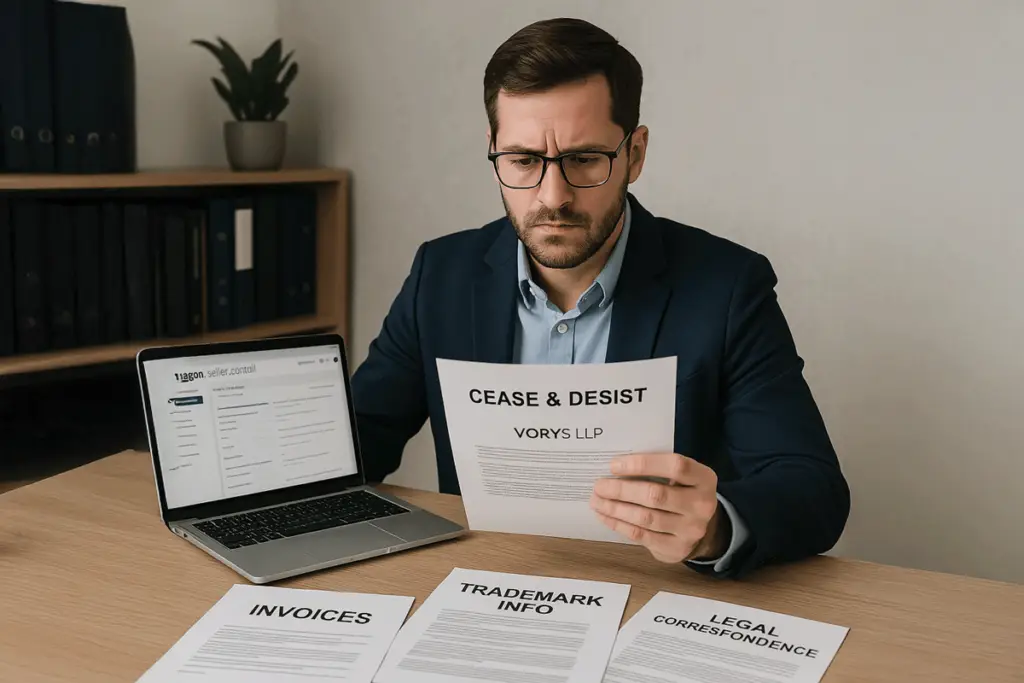5 Common Mistakes Amazon Sellers Make When Responding to a Vorys Letter

Introduction
Many sellers make critical mistakes responding to a Vorys letter—and those errors can lead to Amazon account suspensions, lost income, or even legal threats. A Vorys letter often demands that you stop selling certain products, citing trademark infringement or unauthorized sales. While these letters may seem intimidating, your response is key to protecting your Amazon business.
In this guide, we outline the top mistakes responding to a Vorys letter and how to avoid them.
What Is a Vorys Letter, and Why Should Amazon Sellers Be Cautious?
A Vorys letter is a cease-and-desist communication from the law firm Vorys, Sater, Seymour and Pease LLP, sent on behalf of brands to stop unauthorized resellers on platforms like Amazon. These letters often accuse sellers of trademark infringement or selling “gray market” goods—even if the products are genuine.
Understanding the legal and Amazon policy implications is essential before you respond.
Mistake #1: Admitting Fault Too Soon
One of the most damaging mistakes responding to a Vorys letter is admitting fault without reviewing your legal rights.
Why this matters:
You may accidentally confirm their allegations.
Amazon could use your response to flag or remove your listings.
It weakens your position in any future negotiations or disputes.
What to do instead:
Get legal review before responding. Never admit guilt in writing or agree to take down listings until you fully understand your rights under the First Sale Doctrine.
For professional guidance, visit AmazonSellersLawyer.com.
Mistake #2: Ignoring the Vorys Letter Completely
Another common mistake when responding to a Vorys letter is doing nothing at all. Some sellers think the issue will disappear. Unfortunately, that’s rarely true.
Why this is risky:
Brands may escalate to filing IP complaints with Amazon.
Listings may be removed.
Repeat issues can lead to account deactivation.
Best practice:
Work with an Amazon attorney to issue a strong, fact-based reply. A non-response often worsens your situation.
Mistake #3: Taking Down Listings Without Understanding the Claim
Many sellers panic and remove listings to avoid conflict. But removing listings can backfire if done prematurely.
Key risks include:
Loss of revenue
Involuntary acknowledgment of wrongdoing
Missed opportunity to defend a lawful right to resell
Alternative approach:
Only remove listings if they violate Amazon policies or if you’re actually selling unauthorized or materially different goods. Otherwise, stand your ground with documented proof.
Learn more about IP protection at BrandEnforcementLaw.com.
Mistake #4: Sending a Hostile or Emotional Response
A Vorys letter can feel personal—but your reply shouldn’t be.
Common problems with emotional responses:
Brands may escalate to legal action
Unprofessional tone hurts credibility
Aggressive language may be forwarded to Amazon
Solution:
Keep your tone calm, respectful, and focused on facts. Let legal professionals take the lead if emotions are running high.
Mistake #5: Not Backing Up Your Case with Documentation
Perhaps the most overlooked mistake responding to a Vorys letter is failing to provide supporting documentation.
Why documentation matters:
Amazon won’t act without proof of authenticity
It shows you’re a legitimate seller, not a counterfeit source
It helps defend against claims under the First Sale Doctrine
What to provide:
Invoices from authorized distributors
Purchase orders
Supplier contact info and product photos
Documentation is your strongest weapon in avoiding listing takedowns and protecting your seller account.
Final Thoughts on Avoiding Mistakes Responding to a Vorys Letter
Responding to a Vorys letter the wrong way can jeopardize your Amazon business. But by avoiding these 5 key mistakes—admitting fault, ignoring the letter, reacting emotionally, prematurely removing listings, and failing to show documentation—you protect your account and preserve your right to sell.
For tailored legal support from attorneys who know Amazon inside and out, contact us at AmazonSellersLawyer.com. Or, for deeper insight into intellectual property rights, visit BrandEnforcementLaw.com.
